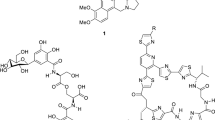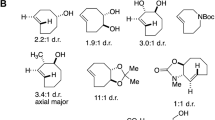Abstract
Reported herein is the design of a new catalytic paradigm by synergistically combining sequential paired electrosynthesis with halogen-bonding (XB) activation for the cyclization of organochlorides with olefins. This dual activation strategy enables rapid access to densely functionalized 2-alkylidene-tetrahydrofurans with exclusive Z-selectivities, which are challenging to be synthesized by other methods. 4,4′-Di-tert-butyl-2,2′-bipyridine (dtbbpy) showed an unprecedented reactivity as a XB acceptor to activate C-Cl bond by shifting its reduction potential positively by 220 mV. Distinctly different from previous electro-reductions of C-Cl bonds relying upon high electrode potentials or matched redox properties between mediators and organochlorides, the XB activator employed herein has no limit on the abovementioned redox property matching but can lower the applied electrode potentials The decreased operating potential allows broad functional group tolerance, which was highlighted by the late-stage functionalization of 11 examples of drugs and natural products-derived alkenes.

Similar content being viewed by others
References
Xiong P, Xu HC. Acc Chem Res, 2019, 52: 3339–3350
Wang F, Stahl SS. Acc Chem Res, 2020, 53: 561–574
Meyer TH, Choi I, Tian C, Ackermann L. Chem, 2020, 6: 2484–2496
Siu JC, Fu N, Lin S. Acc Chem Res, 2020, 53: 547–560
Ma C, Fang P, Liu ZR, Xu SS, Xu K, Cheng X, Lei A, Xu HC, Zeng C, Mei TS. Sci Bull, 2021, 66: 2412–2429
Cheng X, Lei A, Mei TS, Xu HC, Xu K, Zeng C. CCS Chem, 2022, 4: 1120–1152
Ackermann L. Acc Chem Res, 2020, 53: 84–104
Ma C, Fang P, Liu D, Jiao KJ, Gao PS, Qiu H, Mei TS. Chem Sci, 2021, 12: 12866–12873
Malapit CA, Prater MB, Cabrera-Pardo JR, Li M, Pham TD, McFadden TP, Blank S, Minteer SD. Chem Rev, 2022, 122: 3180–3218
Duñach E, Medeiros MJ, Olivero S. Electrochim Acta, 2017, 242: 373–381
Shimakoshi H, Hisaeda Y. Chem Rec, 2021, 21: 2080–2094
Zhang W, Lu L, Zhang W, Wang Y, Ware SD, Mondragon J, Rein J, Strotman N, Lehnherr D, See KA, Lin S. Nature, 2022, 604: 292–297
Mubarak MS, Peters DG. Curr Opin Electrochem, 2017, 2: 60–66
Lu L, Li H, Zheng Y, Bu F, Lei A. CCS Chem, 2021, 3: 2669–2675
Mitsudo K, Nakagawa Y, Mizukawa J, Tanaka H, Akaba R, Okada T, Suga S. Electrochim Acta, 2012, 82: 444–449
Olivero S, Rolland JP, Duñach E. Organometallics, 1998, 17: 3747–3753
Esteves AP, Freitas AM, Medeiros MJ, Pletcher D. J Electroanal Chem, 2001, 499: 95–102
Gennaro A, Isse AA, Maran F. J Electroanal Chem, 2001, 507: 124–134
Kim H, Kim H, Lambert TH, Lin S. J Am Chem Soc, 2020, 142: 2087–2092
Cowper NGW, Chernowsky CP, Williams OP, Wickens ZK. J Am Chem Soc, 2020, 142: 2093–2099
Tian X, Karl TA, Reiter S, Yakubov S, de Vivie-Riedle R, König B, Barham JP. Angew Chem Int Ed, 2021, 60: 20817–20825
Wu S, Kaur J, Karl TA, Tian X, Barham JP. Angew Chem Int Ed, 2022, 61: e202107811
Wu S, Žurauskas J, Domański M, Hitzfeld PS, Butera V, Scott DJ, Rehbein J, Kumar A, Thyrhaug E, Hauer J, Barham JP. Org Chem Front, 2021, 8: 1132–1142
Jeong DY, Lee DS, Lee HL, Nah S, Lee JY, Cho EJ, You Y. ACS Catal, 2022, 12: 6047–6059
Gilday LC, Robinson SW, Barendt TA, Langton MJ, Mullaney BR, Beer PD. Chem Rev, 2015, 115: 7118–7195
Cavallo G, Metrangolo P, Milani R, Pilati T, Priimagi A, Resnati G, Terraneo G. Chem Rev, 2016, 116: 2478–2601
Kolář MH, Hobza P. Chem Rev, 2016, 116: 5155–5187
Robidas R, Reinhard DL, Legault CY, Huber SM. Chem Rec, 2021, 21: 1912–1927
Tsuji N, Kobayashi Y, Takemoto Y. Chem Commun, 2014, 50: 13691–13694
Castelli R, Schindler S, Walter SM, Kniep F, Overkleeft HS, Van der Marel GA, Huber SM, Codée JDC. Chem Asian J, 2014, 9: 2095–2098
Fave C, Schöllhorn B. Curr Opin Electrochem, 2019, 15: 89–96
Rasol NE, Naz H, Awang K, Ridhwan MJM, Choy YK, Ismail NH. Nat Prod Commun, 2017, 12: 1283–1286
Zhang S, Li L, Li J, Shi J, Xu K, Gao W, Zong L, Li G, Findlater M. Angew Chem Int Ed, 2021, 60: 7275–7282
Jiang Y, Xu K, Zeng C. CCS Chem, 2022, 4: 1796–1805
Tan Z, He X, Xu K, Zeng C. ChemSusChem, 2022, 15: e202102360
Hilt G. ChemElectroChem, 2020, 7: 395–405
Wu T, Moeller KD. Angew Chem Int Ed, 2021, 60: 12883–12890
Mo Y, Lu Z, Rughoobur G, Patil P, Gershenfeld N, Akinwande AI, Buchwald SL, Jensen KF. Science, 2020, 368: 1352–1357
Dong X, Roeckl JL, Waldvogel SR, Morandi B. Science, 2021, 371: 507–514
Claraz A, Masson G. ACS Org Inorg Au, 2022, 2: 126–147
Yan X, Wang S, Liu Z, Luo Y, Wang P, Shi W, Qi X, Huang Z, Lei A. Sci China Chem, 2022, 65: 762–770
Ang NWJ, Ackermann L. Chem Eur J, 2021, 27: 4883–4887
Zhu C, Yue H, Jia J, Rueping M. Angew Chem Int Ed, 2021, 60: 17810–17831
Claros M, Ungeheuer F, Franco F, Martin-Diaconescu V, Casitas A, Lloret-Fillol J. Angew Chem Int Ed, 2019, 58: 4869–4874
Giedyk M, Narobe R, Weiß S, Touraud D, Kunz W, König B. Nat Catal, 2020, 3: 40–47
The cathodic potential during the reaction at room temperature ranges from −1.52 to −1.65 V, which is sufficient to reduce the C-Cl bonds
Kaur J, Shahin A, Barham JP. Org Lett, 2021, 23: 2002–2006
Li T, Liang K, Tang J, Ding Y, Tong X, Xia C. Chem Sci, 2021, 12: 15655–15661
Kato N, Nanjo T, Takemoto Y. ACS Catal, 2022, 12: 7843–7849
Tasnim T, Ryan C, Christensen ML, Fennell CJ, Pitre SP. Org Lett, 2022, 24: 446–450
Acknowledgements
This work was supported by the National Natural Science Foundation of China (21871019, 22171015), Beijing Municipal Education Committee Project (KZ202110005003, KM202110005006), and Beijing Natural Science Foundation (2222003). We also extend our thanks to the Large-scale Instruments and Equipments Sharing Platform of Beijing University of Technology for NMR experiments.
Author information
Authors and Affiliations
Corresponding authors
Ethics declarations
Conflict of interest The authors declare no conflict of interest.
Additional information
Supporting information The supporting information is available online at http://chem.scichina.com and http://link.springer.com/journal/11426. The supporting materials are published as submitted, without typesetting or editing. The responsibility for scientific accuracy and content remains entirely with the authors.
Supporting Information
11426_2022_1410_MOESM1_ESM.pdf
The Synergism of Sequential Paired Electrosynthesis with Halogen Bonding Activation for the Cyclization of Organochlorides with Olefins
Rights and permissions
About this article
Cite this article
Lian, F., Xu, K. & Zeng, C. The synergism of sequential paired electrosynthesis with halogen bonding activation for the cyclization of organochlorides with olefins. Sci. China Chem. 66, 540–547 (2023). https://doi.org/10.1007/s11426-022-1410-6
Received:
Accepted:
Published:
Issue Date:
DOI: https://doi.org/10.1007/s11426-022-1410-6




